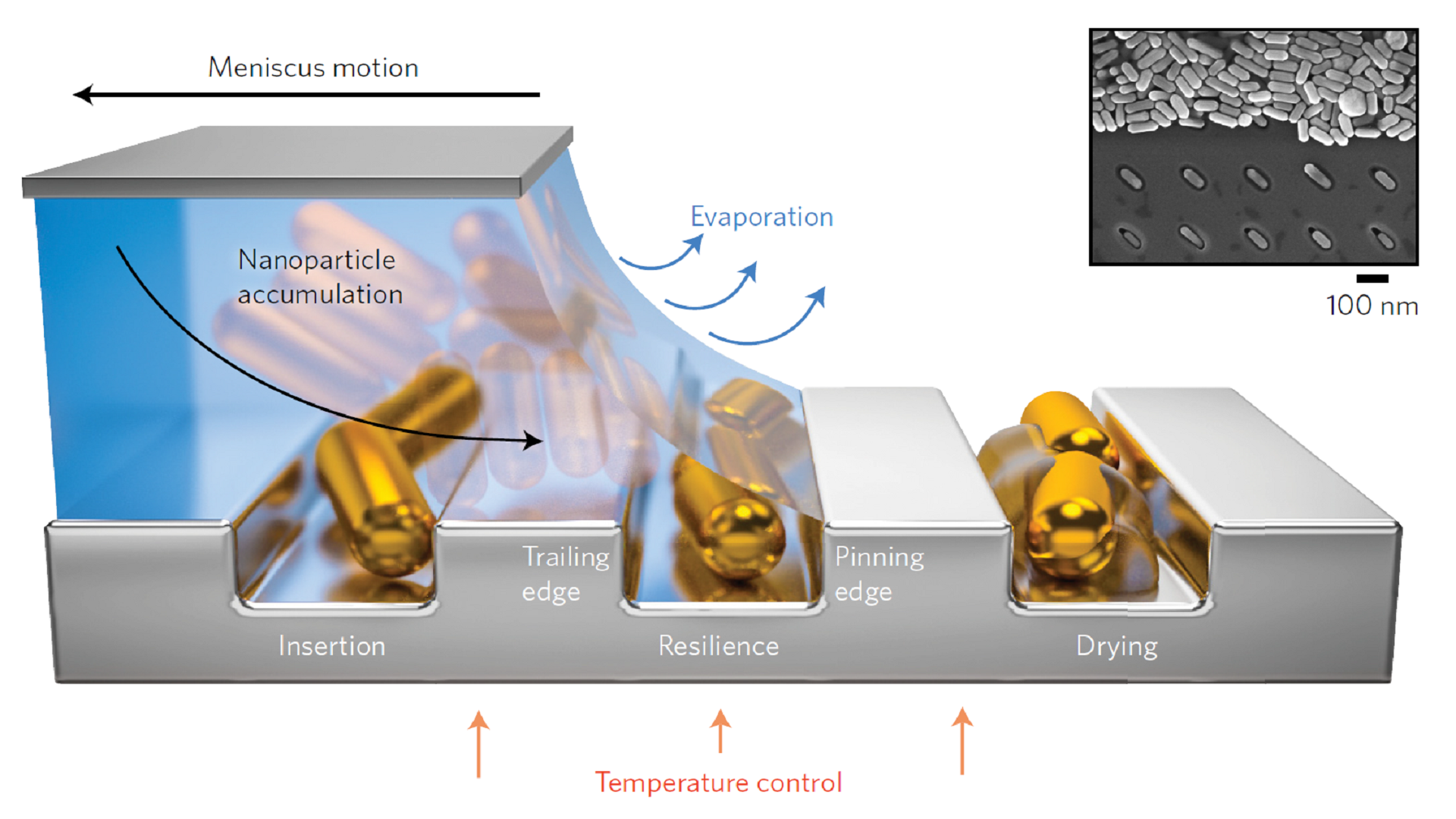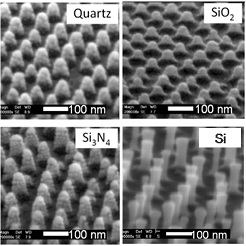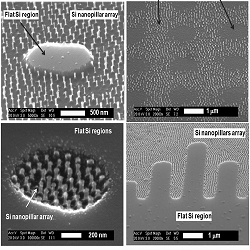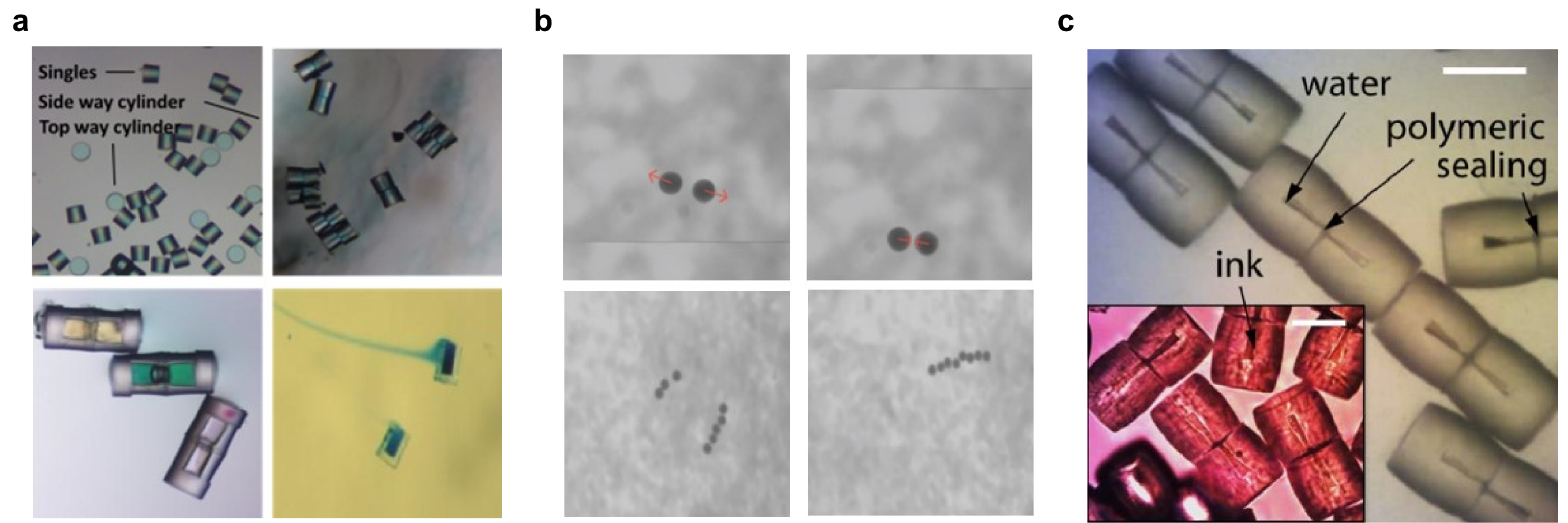Introduction
Predetermined and selective placement of nanoparticles onto large-area substrates with nanometre-scale precision is essential to harness the unique properties of nanoparticle assemblies, in particular for functional optical and electrooptical nanodevices. Unfortunately, such high spatial organization is currently beyond the reach of top-down nanofabrication techniques alone. Here, we demonstrate that topographic features comprising lithographed funnelled traps and auxiliary sidewalls on a solid substrate can deterministically direct the capillary assembly of Au nanorods to attain simultaneous control of position, orientation and interparticle distance at the nanometre level. We report up to 100% assembly yield over centimetre-scale substrates. We achieve this by optimizing the three sequential stages of capillary nanoparticle assembly: insertion of nanorods into the traps, resilience against the receding suspension front and drying of the residual solvent. Finally, using electron energy-loss spectroscopy we characterize the spectral response and near-field properties of spatially programmable Au nanorod dimers, highlighting the opportunities for precise tunability of the plasmonic modes in larger assemblies.

Self-assembly
Our work on nanoscale assembly:
 |
We demonstrate the controlled tuning of the characteristic dimensions of two-dimensional arrays of block-copolymer micelles. The arrays are obtained by spin-coating a solution of PS-b-P2VP (polystyrene-block-poly(2-vinylpyridine) micelles. The array periodicity, for example, can be systematically varied by changing the polymer concentration, the solvent composition, or the spin-coating parameters. The whole process is 4″ wafer compatible. |
 |
Block copolymer micelle lithography has been used to create nanopillars of tunable dimensions and different densities. Nanopillar arrays have been fabricated on different substrates such as silicon, silicon dioxide, silicon nitride and quartz. In this way, different functional surfaces and membranes have been fabricated, e.g. super-hydrophobic surfaces and nanoporous polymeric membranes and controlling the areal density of physical vapor deposition derived titanium nitride nanostructures. |
 |
Combining block copolymer micelle lithography with stencil lithography is an excellent example for the combination of top-down with bottom-up fabrication methods. It offers a simple and cost-efficient means for the patterning of nanostructured surfaces. The stencil patterning can be done on the micron- and on the nano-scale. Complementary micro-/nanoarchitectures could thus be fabricated. The use of stencil lithography for the patterning of the nanoscale structures has several advantages over photoresist based patterning, particularly for the integration of nanostructures into on-chip device architectures. |
 |
Self-assembled polystyrene nanospheres are deposited on 4″ substrates by spin-coating. An initial template of wafer-scale monolayers of hexagonally close-packed beads can thus be realized. The dot array template can then be transferred into either dot or hole arrays in silicon based materials or metals. High aspect ratio silicon nanopillars, nanoporous SiN membranes and nanoporous thin metal films have been fabricated. The applications of such structures range from functional surfaces, filtration membranes or membranes for cell growth, over structures for optical effects to plasmonics. |
Our work on microscale assembly:
Self-assembly of micro-components allows us to assemble huge number of micro-objects in scalable and parallel manner where the standard pick-and-place approach is fastidious. We demonstrate self-assembly of simple bicolor SU-8 cylinders as well as half capsules for liquid encapsulation and release. To ensure a successful encapsulation, face-selective surface functionalization has to be done by a silane “lift-off-like” process resulting in only one surface selectively more hydrophobic than all other ones. The half-capsules could be self-assembled in aqueous solutions into complete capsules encapsulating the solution with a yield above 95%, which could also be subsequently released in another medium.
We demonstrate self-assembly of microstructures by magnetic force. Microstrucutres of a superparamagnetic composite have been fabricated by inkjet printing. The structures have been made such that they involve magnetic easy axis. Bringing the structures in a fluidic phase allows to control them by an external magnetic field, allowing their self-organization and self-assembly. As a demonstrated their attraction and repulsion is shown as well as their self-organization into lines.

100 um half-capsules are fabricated by photolithography based on a prefabricated silicon substrate. The half-capsules are made hydrophilic except one surface kept hydrophobic. This allows in a fluidic phase to selectively precipitate a polymer solution – acting as a UV-glue – onto the surfaces of the half-capsules which will self-assemble into complete capsules. This leads us to sealed microcapsules encapsulating surrounding media. As a proof of concept, colored ink as been encapsulated.
Keywords: assembly, self-assembly
Journal papers
Please note that the publication lists from Infoscience integrated into the EPFL website, lab or people pages are frozen following the launch of the new version of platform. The owners of these pages are invited to recreate their publication list from Infoscience. For any assistance, please consult the Infoscience help or contact support.
Mode Evolution in Strongly Coupled Plasmonic Dolmens Fabricated by Templated Assembly
ACS Photonics. 2017. Vol. 4, num. 7, p. 1661-1668. DOI : 10.1021/acsphotonics.6b01026.Nanoscale topographical control of capillary assembly of nanoparticles
Nature Nanotechnology. 2017. Vol. 12, num. 1, p. 73-80. DOI : 10.1038/nnano.2016.179.Inkjet printed superparamagnetic polymer composite hemispheres with programmed magnetic anisotropy
Nanoscale. 2014. Vol. 6, p. 10495-10499. DOI : 10.1039/C3NR06442E.Three-dimensional polymeric microtiles for optically-tracked fluidic self-assembly
Microelectronic Engineering. 2014. Vol. 124, p. 1-7. DOI : 10.1016/j.mee.2014.04.017.Acousto-fluidic system assisting in-liquid self-assembly of microcomponents
Journal of Micromechanics and Microengineering. 2013. Vol. 23, num. 12, p. 125026. DOI : 10.1088/0960-1317/23/12/125026.Fluid-mediated parallel self-assembly of polymeric micro-capsules for liquid encapsulation and release
Soft Matter. 2013. Vol. 9, p. 9931-9938. DOI : 10.1039/c3sm51923f.Conference papers
Please note that the publication lists from Infoscience integrated into the EPFL website, lab or people pages are frozen following the launch of the new version of platform. The owners of these pages are invited to recreate their publication list from Infoscience. For any assistance, please consult the Infoscience help or contact support.